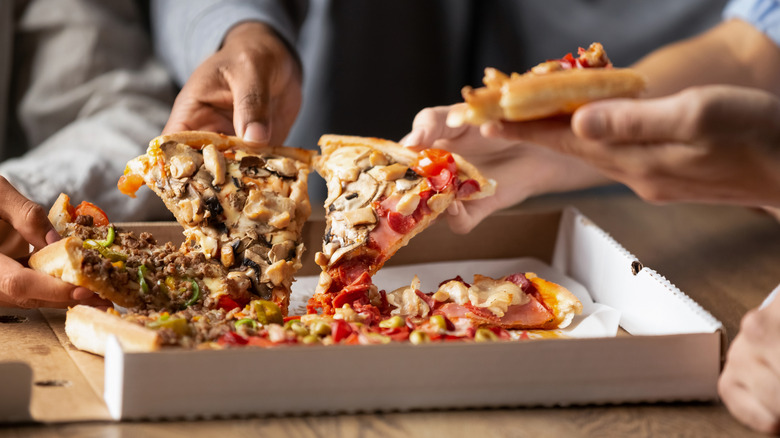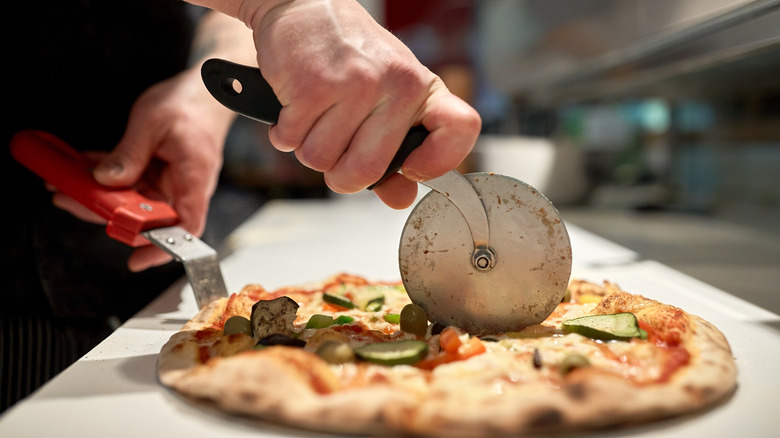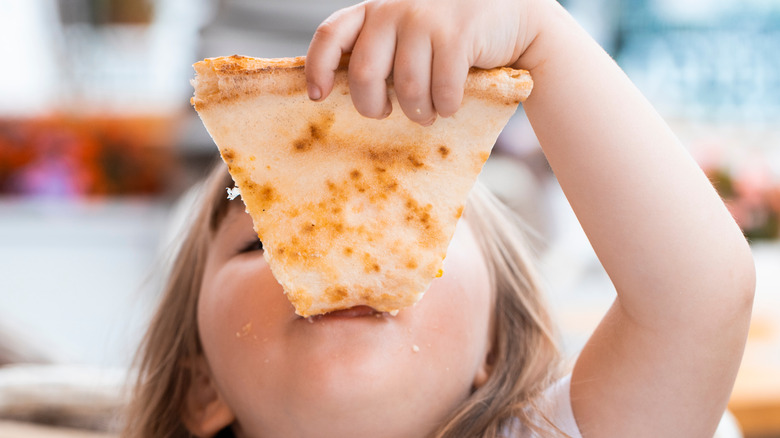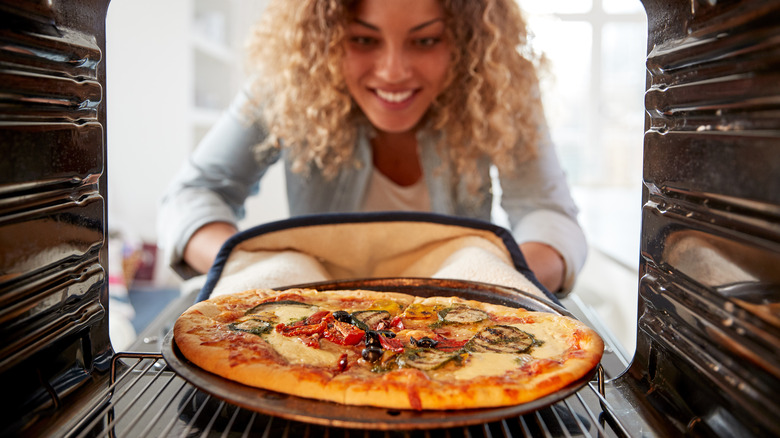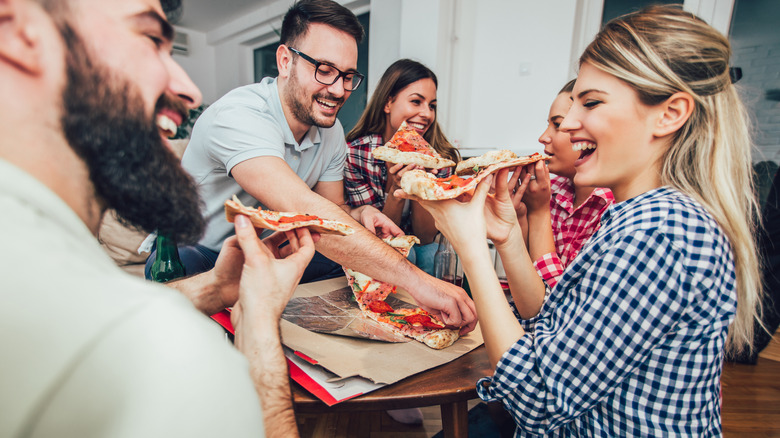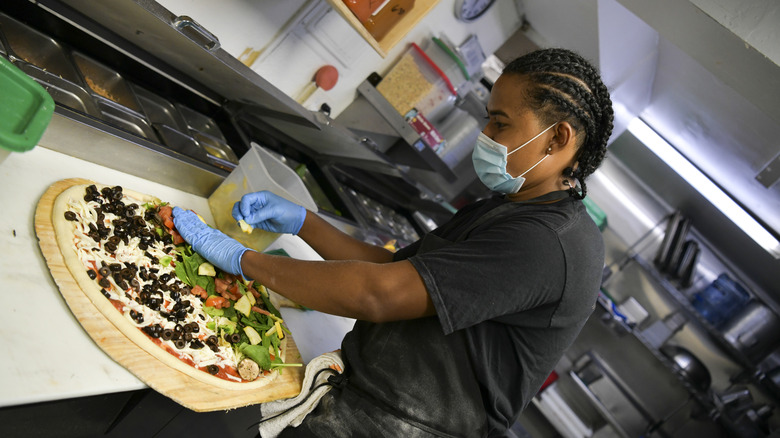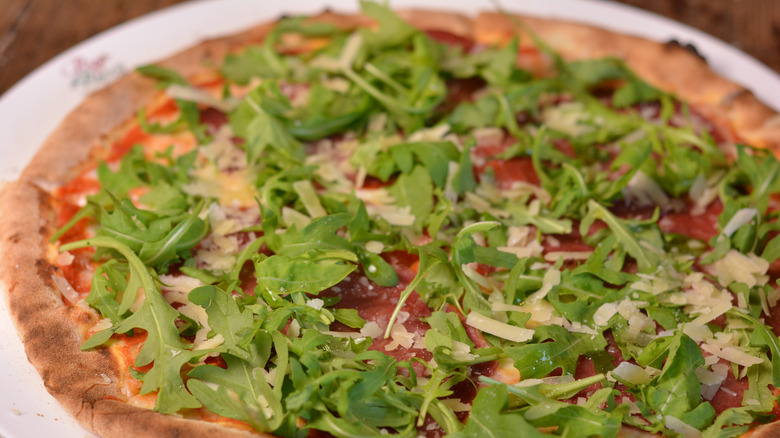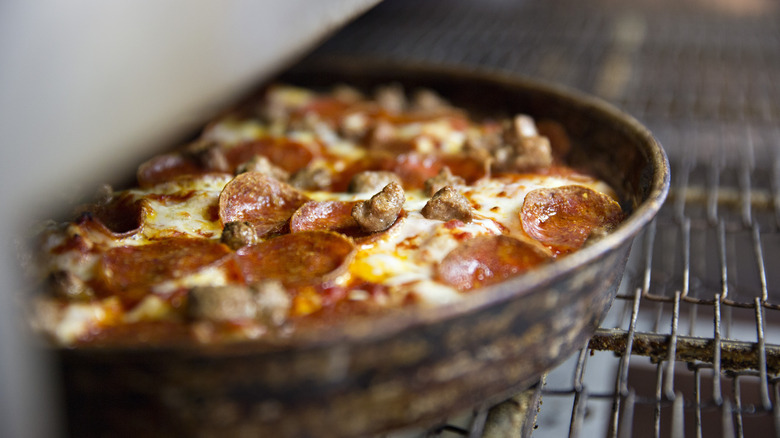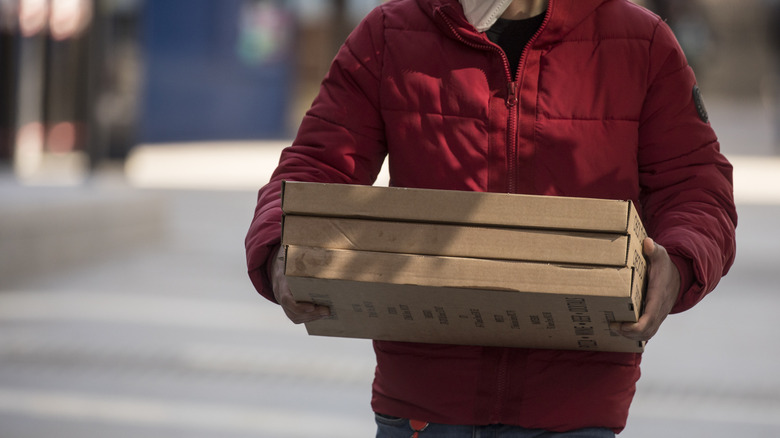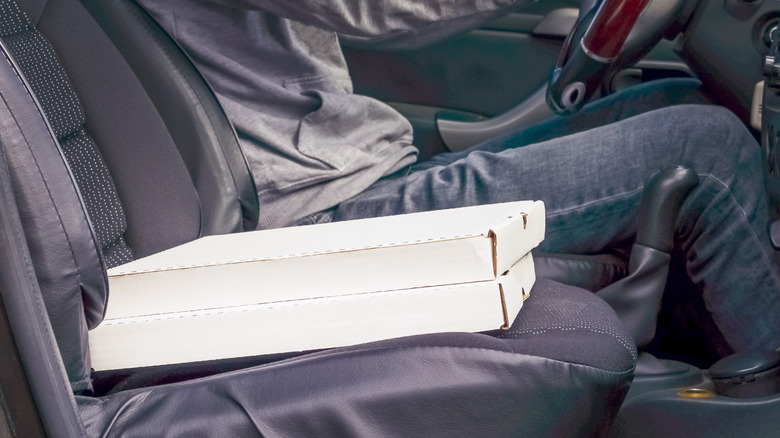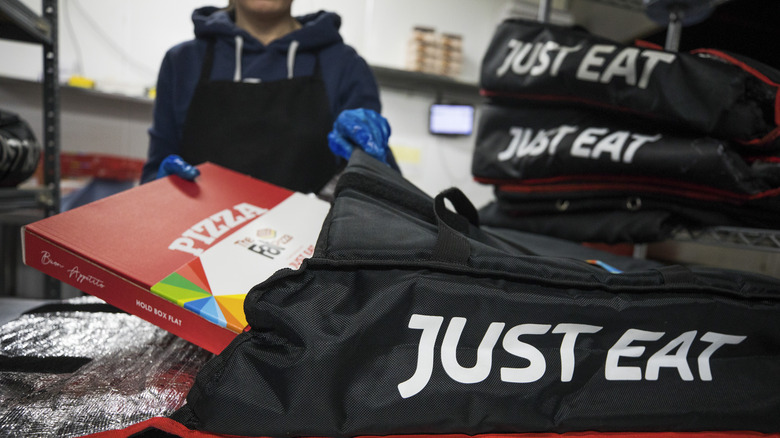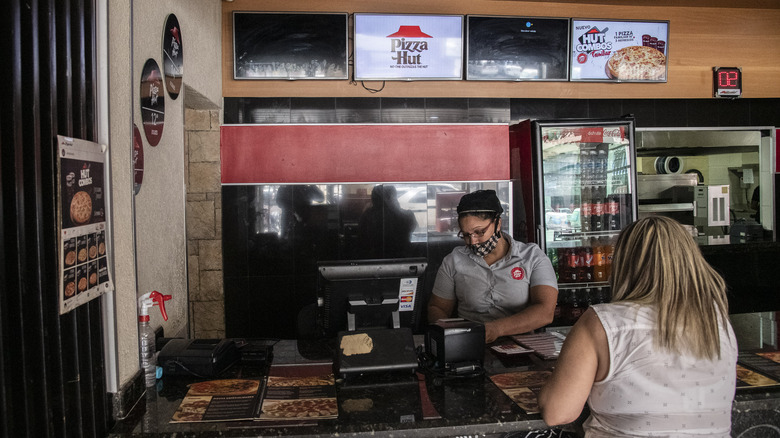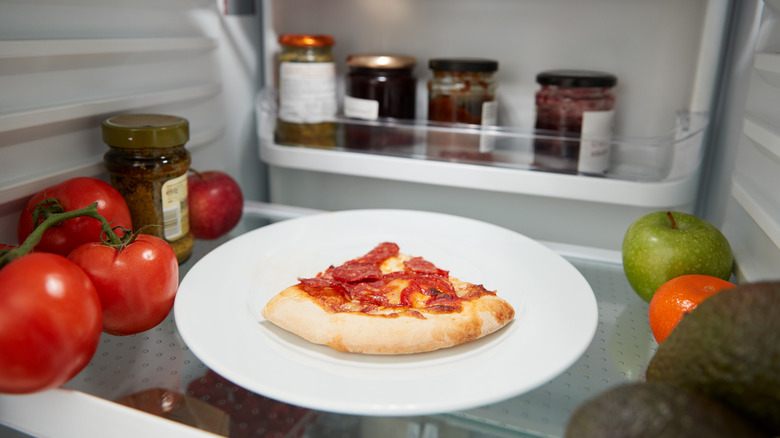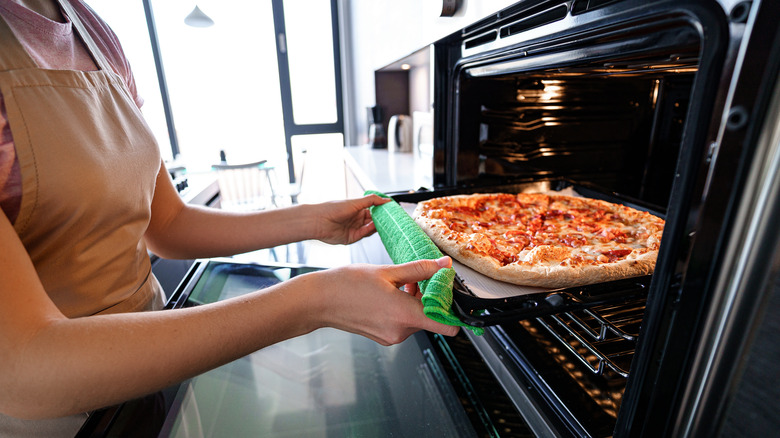Mistakes Everyone Makes When Ordering Pizza
Thick or thin crust, extra cheese or barely any cheese at all, all the toppings or mere pepperoni — however you like your pizza, there's no denying that you more than likely order pizza from your favorite local pizzeria or national pizza chain on a semi-frequent basis. After all, consumer spending on pizza delivery in the United States, according to Statista, reached a total of $14 billion in 2020, an increase of approximately $3 billion over 2019. That's a lot of people ordering pizza! But could you be doing a better job when you place that next pizza order? Is there something you could be doing (or not doing) to guarantee a better pizza experience, no matter what pizza place you're ordering from?
Turns out, there are actually quite a few things you can do to make your take-out or delivery pizza just a little bit better, both straight from the box and even days later, when you're reheating those delicious leftovers. Check out these mistakes everyone makes when ordering pizza, so you can avoid them in the future.
Not asking to cut your pizza yourself
We know, we know. Why create more work for yourself? Ordering pizza is supposed to be the easiest, most hands-off dinner ever. However, cutting your pizza yourself, once you get it home or once the pizza is delivered, comes with a whole bevy of benefits you should definitely know about.
Asking for your pizza uncut, as On Milwaukee points out, results in an overall better cut. You get exactly the shapes and sizes of slices you want if you do it yourself; plus, you're likely to show the job a little more care than the teenager who is (probably) throwing your pizza into the box in a hurry. Additionally, if you're worried about your pizza growing cold during transportation, asking for your pizza uncut will help it retain more heat until it reaches your house (cut food chills faster; it's just science). And, lastly, if you prefer a crispy crust, only cutting your pizza seconds before you eat it will help you keep that crispy crust actually crispy, as the sauce and other liquid-y toppings won't be dripping down into the cut crust the entire time it takes for the pizza to reach you.
Not asking for a particular type of cut under certain circumstances
Although you do want to refrain from asking for your pizza cut under most circumstances, there are certain times when you'll want to ask for your pizza not only cut, but "double cut." A double cut pizza is simply cut into double the normal number of slices. This route you want to go when you're feeding children (their little hands can more easily manage the smaller slices) or just when you're feeding a crowd. When it comes to feeding adults a double-cut pizza, those smaller sizes will likely still result in less waste (adults get full, too!) — and they'll also give everyone the opportunity to try more than one toping variety without overstuffing their stomachs, if you've ordered a few.
Never heard of double cut pizza? Your local pizza shop probably has, so no worries there. We promise you won't confuse the person taking your order when you ask for it.
Not reheating your pizza as soon as it arrives
But why, you ask, would I reheat my pizza as soon as it arrives? It's already hot — or at least, it better be. You're paying for hot pizza, right?
While the hope is always that you open up that delivery box to a steaming pie, chances are likely that your delivery pizza isn't as hot as it could be (it's not straight from the oven, after all), and reheating your pizza before you dig in is a simple way to make a big upgrade. It's more convenient than you probably think, too. You just want to ensure you reheat your pizza the correct way.
On Milwaukee recommends preheating your oven to 500 degrees Fahrenheit (either as soon as you place that delivery order, or as soon as you get home from picking up your pie), and putting a baking sheet into the oven to heat up with it. Once the oven (and pan) have reached the ideal temperature, toss your pizza onto that piping hot baking sheet, and then let it heat up for about five minutes. This not only guarantees a truly hot pizza, but it also can help crisp up a crust that's gone a little soggy during transit.
Of course, this is much easier to do if the pizza is one piece — just one more reason to ask for it to be uncut.
Not correctly calculating how much pizza you'll truly need for a group
If you're feeding a group — whether that's just a large family or a big party — there's nothing worse than realizing that you've not prepared enough food. It's just as disheartening to realize you've ordered way too much and wasted money on pizza that didn't get eaten. The next time you feed a crowd, pizza is usually a safe way to go (after all, who doesn't love pizza?), but you want to ensure that you actually have enough pizza to feed everyone. According to pizza restaurant Giordano's, there are a few quick tricks for calculating how much pizza you'll truly need for a group, starting with the 3/8 rule.
The 3/8 rule assumes that most medium pizzas are cut into eight slices and the average person will eat three slices of a medium pizza. So, to find out the number of pizzas you need for a group, just multiply the number of guests by 3/8 and then round up. So, if you have 10 guests, you need four pizzas. If you have 20 guests, you need eight pizzas, and so forth.
You can adjust the formula to account for larger or smaller pizza sizes with more or fewer numbers of pizza slices, as well as to account for hungrier or less hungry guests that may not eat an average of three slices (such as children, who may only eat two). You can also adjust the number of slices each person will eat by what type of pizza you're ordering; adults are more likely to eat more slices of a thin-crust pizza than they are a deep dish pizza.
Ordering too many toppings on your pizza
Pepperoni, sausage, bacon, peppers, onions, olives! If your motto with pizza toppings is "more is better," you may want to reconsider the next time you order a pie. While all those extra flavors and textures can make a pizza great, according to one former Domino's employee, the more toppings you order, the less the quantity of each topping a pizza worker will add to your pizza. So, hypothetically, if you only order two toppings on your pizza, you'd get a larger quantity of each of those two toppings on your pie than you would if you ordered six toppings on your pizza. In other words, more toppings does not actually equal more overall food.
The employee says, at least at Domino's, "There are three price brackets for toppings: one to two toppings, three to four toppings, and five or more toppings. You might think that [by] getting nine toppings, you're ripping Domino's off but really you're just playing yourself because once you go over four toppings, you're actually getting less of every topping."
Not adding some toppings yourself
But that hardly means you need to forgo your pizza piled high with every topping imaginable. Instead, you just need to add those toppings that you want, yourself. This will ensure you get fresher toppings, but also that you get the exact amount of each topping that you want.
Men's Health recommends adding sliced onions, greens (think arugula, spinach, or whatever leafy greens you have on hand), and hot peppers to your pizza to start. These can all give your pizza a flavor boost, especially if your pizza is on the greasy side, with a primary texture of soft melted cheese. For the ultimate in convenience, start prepping your toppings as soon as you place your pizza order, so that when your pizza arrives, all you need to do is throw them on top — after, of course, you reheat your pizza to crisp up that crust and ensure each slice is piping hot.
Not asking for your pizza well done
Well-trained foodies typically avoid ordering anything "well done," but when it comes to your pizza, you may want to consider asking for just that. A well done pizza generally only takes a few minutes more to make, but those extra minutes in the oven make a big difference, resulting in a pizza with a crispier, tastier crust and more thoroughly cooked toppings. In the end, you get a more delicious pizza, a fact that Thrillist blames on the maillard reaction.
What exactly is the maillard reaction? No, it has nothing to do with ducks. This chemical reaction basically the transformation of sugars and proteins that occurs when food cooks, resulting in new flavors and aromas that are particularly tempting to the human palate.
So, forgo your limp pizza slice with the still-white mozzarella and the barely-cooked vegetables, and ask for your pizza well done next time.
Ordering two smaller pies instead of one larger pie
You're ordering pizza for a family, a few friends, or just for you and you want leftovers. You take a look at your options and decide that two small pizzas is the way to go. After all, surely the two small pizzas are, together, larger than the large pizza ... right? Wrong.
With a little bit of math, one Twitter user calculated the surface area of both two, 12-inch pizzas and one 18-inch pizza, and found that you get more pizza when you order the 18-inch option versus the two, 12-inch pizzas. And yes, while you might say, "But 12 inches doubled is 24 inches, which is larger than 18 inches!" that's not really how pizza math works. At the end of the day, an 18-inch pizza boasts 254 square inches of pizza, whereas two, 12-inch pizzas give you a combined total of only 226 square inches of pizza.
Not keeping your pizza level on the ride home
If you order delivery, the state in which your pizza is transported is pretty much out of your control. That delivery driver can punt your pizza into the back of their car and let it slide around their trunk as they take every suburban corner at frightening speeds and you'll never be the wiser (usually). But if you order takeout, you can be a little more conscious about how you transport your pizza, in order to ensure the best results. To start, try keeping your pizza level on the ride home, for less cheese and topping slippage. The Kitchn explains an easy way to do so, and all it requires is a bottle of soda.
Just lay a 16-ounce soda bottle on its side in the crevice at the back of your car's passenger seat, and then set the pizza boxes onto the seat. The bottle is typically just the right height to make that side of your pizza level with the side lying more toward the front of the seat, for no more slanted pizza.
Not complaining if the pizza place gets your order wrong
Restaurant diners are often split into two camps: the diners who will complain vehemently anytime anything at all goes wrong with an order, and diners who'd rather just keep quiet and deal with a potentially incorrect meal. If you fall into the latter group, you may be doing yourself a disservice, as complaining when the pizza place gets your order wrong can sometimes result in free food. (And everyone likes free food, right?)
According to a former Domino's Pizza employee, it's incredibly easy to get free food if you just call up the pizza place and (nicely) let them know you're not happy. While the past employee does note that Domino's, as an international chain, is working with some decent profit margins that allow the brand to do this, it's worth trying this tactic out at your local pizza places, too (though it might not work every time). Just remember — be nice (not rude) and don't take advantage of the system. Only call your local pizza joint up to complain if there really is a problem with your pizza order. And don't forget them when they go out of their to make it right.
Not being a nice customer
Along these same lines, sometimes you can get free food simply by being a nice and regular customer. As the same Domino's Pizza employee noted, if you become a regular at a specific pizza restaurant (local or a large brand), and you're consistently nice to the employees, they likely won't have any issue treating you on occasion.
The employee says, "For nice people ... I would always try to go the extra mile. Sometimes this meant advising them to trigger a meal deal which would usually giving them more food for less money. Sometimes if we had extra stock of something, my manager would let me give it away for free to customers I liked."
So, whatever the circumstances, treat the food service employees you encounter with respect and a smile, not only because it's the decent thing to do, but also because you might get some free breadsticks (or dessert) out of it. It does pay to be nice, after all!
Not storing your leftover pizza the right way
You get your pizza home, you reheat it, you top it with some fresh veggies, you slice it yourself, you enjoy every bite — your work's done, right? Not quite. In order to ensure you enjoy your leftover pizza just as much tomorrow, you want to store your leftover pizza the right way, and, no, the right way is not simply stuffing the oversized box into your refrigerator.
According to an article in The Grand Island Independent, leaving your pizza in the box overnight or longer results in dried out, lackluster pizza, due to all the airflow. What you want to do instead is take your pizza slices from the box and place them one at a time on a suitably-sized dinner plate, alternating pizza slices and sheets of wax paper, parchment paper, or aluminum foil. Once all of the slices are stacked, cover your pizza tower with plastic wrap and then place the tower, plate and all, in the fridge. Not only do you save room in your fridge, but you also keep your pizza from drying out.
Not reheating your leftover pizza the right way
Finally, when it's time to enjoy your leftover pizza, you have to reheat those slices correctly. Otherwise, all your hard work to preserve them is for naught! There are several ways you can go about reheating your leftover pizza.
If you're using the oven, reheat your pizza at 375 degrees Fahrenheit, on a foil-lined baking sheet, for about 10 minutes. If you want to use the skillet method, put your cold pizza in a non-stick skillet, heat the skillet up, add a few drops of water into the pan, cover the skillet, and wait. The skillet will brown the bottom of the pizza and crisp it up, while the water helps the toppings and cheese get all steamy and melty.
What you absolutely don't want to do? Avoid the temptation to simply throw your pizza onto a plate and into the microwave. That's a recipe for soggy, sad pizza.
